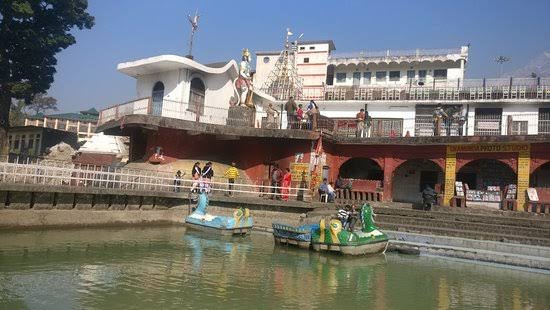Chamunda Devi temple is an located in Himachal Pradesh, India. The temple is around 700 years old. Chamunda is an aspects of Goddess Devi. The temple is also known as Chamunda Nandikeshwar Dham. It is believed that the Lord Shiva and Goddess Shakti reside in this temple. Lord Shiva resides near this temple in the form of Lord Nandikeshwar. In Hinduism, Chamunda is an aspect of Goddess Devi, the supreme Goddess. The name is a combination of Chanda and Munda, two monsters which Devi killed. Goddess Devi appeared to the priest in a dream and asking in to dig in a image of Goddess Chamunda Devi was un erthed and conscret in this temple and worship in the form of Goddess Chamunda Devi. The temple is situated on the banks of river Baner, the temple is dedicated to Goddess Kali, also known as the Goddess of War. It is believed that once Goddess Chamunda Devi was disturbed by two demons are Chanda and Munda, while she was relaxing on top of a hill. This enraged her immensely, which gave rise to Goddess Kali in a typical tiger skin wearing a garland made of human skull. After she killed both the demons, Goddess Chamunda Devi declared a temple to be built the spot and that Goddess Kali be worshipped as Goddess Chamunda Devi.
History
The temple was built by Raja Umed Singh. As per the legacy, Chamunda was enshrined as chief Goddess with the title of Lord Rudra in the battle between demon Jalandhra and Lord Shiva which made this place famous as “Rudra Chamunda”. Another legacy, has it that “Savarni Manamantra” battle between the gods and demons, Chamunda emerged as Goddess Chamunda from an eyebrow of Goddess “Kaushiki” and was assigned the task of eliminating the demons “Chand” and “Mund”. Goddess Chandika fought a fierce battle with these two demons and at last killed them. Goddess Chandika took the slain heads of the two demons “Chanda” and “Munda” to the Goddess “Kaushiki” who being immensely pleased, blessed Goddess Chamunda and bestowed upon her the title of “Chamunda,” the name which is ancient all around the world.
In the temple surroundings there is a guge pond with images of Lords and people can take bath here. There is sculpture of Goddess Chamunda where she is garlands with serpents, scorpions, and the skulls. Auspicious Festival Navratri is celebrated in this temple. Devotees offer prayers with the combined blessing bestowed with enormous wealth, peace, harmony and never ending prosperity, eliminating all bad and evil effects and negativeness from planetary positioning, disease free life and bondage's.
Benefits of this temple
-
Bestow peace and consciousness, remove lack of confidence
-
Prevent from disease, bestow joy and happiness
-
Remove sufferings and misfortunes, bless abundance of wealth and prosperity
Do:
-
Do pray your Ishta Devata before pilgrimage to Temple.
-
Do contact Temple Devasthanam information centre for enquiry, temple information and for Pooja details etc.
-
Do reserve your travel and accommodation at Temple well in advance.
-
Do bath and wear clean clothes before you enter the temple.
-
Do concentrate on God and Goddess inside the temple.
-
Do maintain silence and recite Om Namahsivaya or your Istamantram to yourself inside the temple.
-
Do observe ancient custom and traditions while in Temple.
-
Do respect religious sentiments at Temple.
-
Do deposit your offerings in the hundi only.
Don't s:
-
Do not come to Temple for any purpose other than worshipping of God and Goddess.
-
Do not smoke at Temple.
-
Do not consume alcoholic drinks at Temple.
-
Do not eat non-vegetarian food in the Kshetram.
-
Do not approach mediators for quick Darshanam. It may cause inconvenient to others.
-
Do not carry any weapon inside the temple.
-
Do not wear any head guards like helmets, caps, turbans and hats inside the temple premises.
-
Do not perform Sastanga Pranama inside the Sanctum Sanctorum.
-
Do not take much time while performing Sparsa Darshanam to God in Garbhagriha.
-
Do not buy spurious prasadams from street vendors.
-
Do not encourage beggars at Temple.
